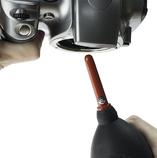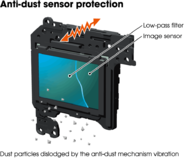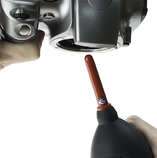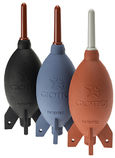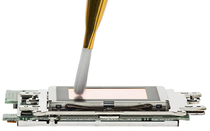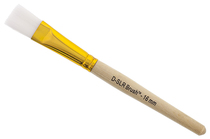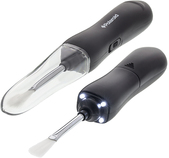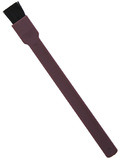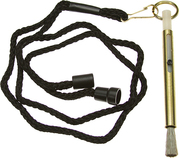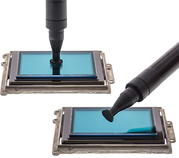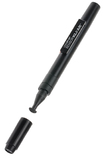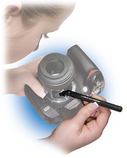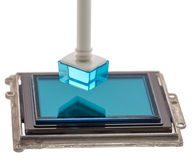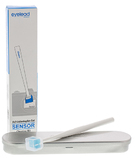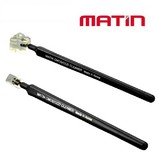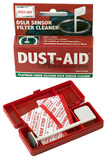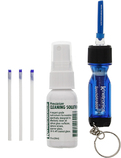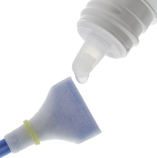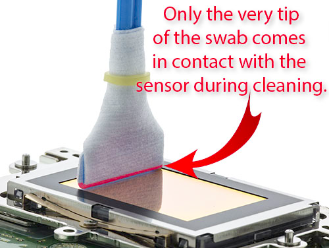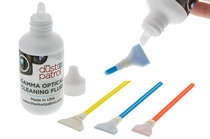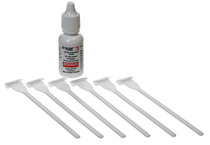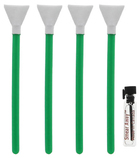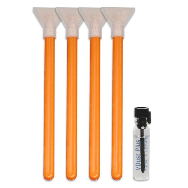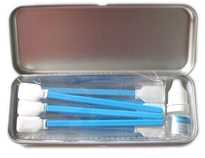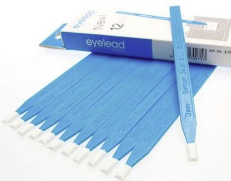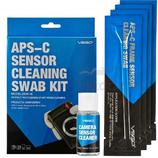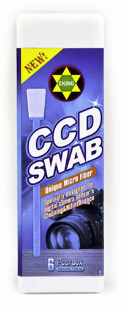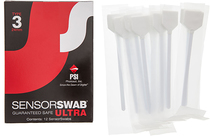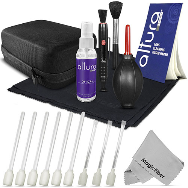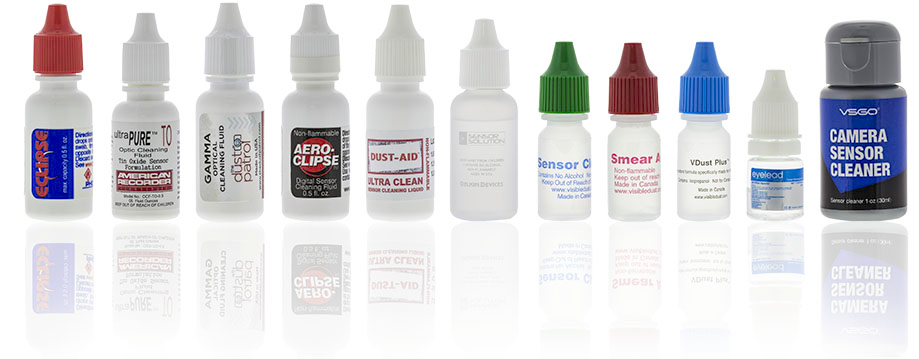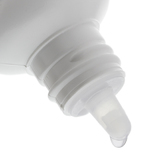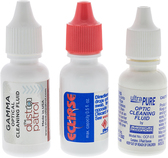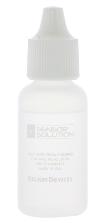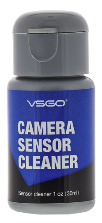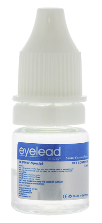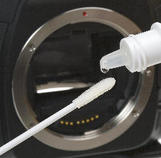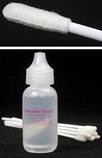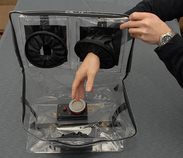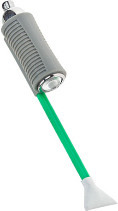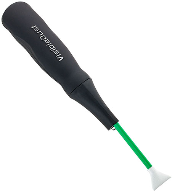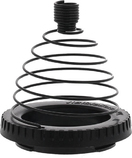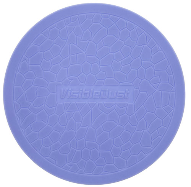Methods & Products
Here we will take a look at all of the commercially available sensor cleaning tools/methods. There are some home remedies and DIY options as well but we won't be discussing them on this page. We have a DYI page if you are brave enough to take the risk. No matter what cleaning method you use, ALWAYS start with a hand blower to make sure all of the big chunks have been removed. NEVER perform any sensor cleaning other than the in-camera integrated sensor shaker without the ability to inspect the sensor. Even a hand blower can make things worse than when you started, so the ability to inspect your work is a MUST. We cover the Sensor Inspection subject/options on a seperate page on www.cleaningdigitalcameras.com
We will be sharing some pricing on this page and would like to clarify some of the terminology that we will be using. The term “street price” refers to the average price you can buy the item for. The item may have a MSRP (manufacturer’s suggested retail price) of $12 but if most dealers are selling it for $11 then the “street price” is $11. MAP (minimum advertised price) is a price set by the manufacturer or distributor that prevents the retailers from advertising the selling price below a certain price. All prices expressed are in US currency.
The Dry Method
The Dry Method should always be your first line of defense when it comes to Sensor Cleaning. The dry method of cleaning digital camera sensors is the method in which no wet chemicals are used. The only disadvantage to using this method is that you won't be able to remove "Welded Dust", a term coined by Thom Hogan.
The following are commonly used Dry Methods
- In-Camera Integrated Sensor Cleaning
- Hand Blower
- SensorKlear
- Gel Stick
- Sensor Cleaning Brush
Since their inception, all manufacturers have recommended a "dry method" to clean the sensor of their DSLRs. This method is the hand blower, as noted in the owner's manual. As a company policy, Canon didn't officially recommend using the lens pen, although I personally received that recommendation along with the foot blower in 2000. Since then, many others have seen Canon Techs at pro events cleaning sensors with lens pens (after using the hand blower to blow all loose items out).
In-Camera Integrated Sensor Cleaning
Supersonic Wave Filter® - Olympus cameras have a cleaning mode that energizes a Supersonic Wave Filter®. This attempts to vibrate the dust off the filter. If the dust is successfully knocked off, it is supposed to be caught by a piece of double stick tape mounted in the lower portion of the mirror cage just next to the CCD. Many other manufacturers have added similar sensor shaking devices to help try dislodge dust.
-
Pros: Built-in. Removes some dust off the sensor.
-
Cons: Not an effective sensor cleaning method.
Blowing
This is the method you will see described in your owner's manual from Canon, Nikon, Olympus, Sigma and Sony. For liability reasons, touching the low pass filter with any item is not recommended by them. However, none of these manufacturers use this as their exclusive in-house method to clean the low pass filters. Blowing should ALWAYS be part of your sensor cleaning routine. In most cases, however, using it as the only cleaning method will not ensure that all dust will be removed. Not all blowers are created equal. Low quality blowers may blow chunks of rubber onto your sensor so using a high quality blower is critical. A more expensive blower is not necessarily of better quality than an inexpensive one. The Giottos Rocket blowers are the best quality on the market and have become the industry standard blower. NEVER use canned or compressed air on a sensor.
Rocket Blower by Giottos - Holding your camera so that the lens mount is facing downward, use the hand blower to remove particles from your sensor. With the blower, use a sweeping motion to help dislodge the particles. Do NOT place the nozzle of the blower inside the body of your camera. Street Price $9.95
- Pros: Blowers are cheap to buy and can be carried almost anywhere. This is a non-physical contact method so chances of damaging the sensor are slim.
- Cons: Will not remove pollen or dust that is attached with moisture. Dust attached with a static charge is also difficult to remove with this method.
Hepa Jet Blower by Koh - This bulb is made of medical grade PVC that is comfortable and hypoallergenic. The replaceable HEPA filter removes humidity and 99.97% of air particles. Street Price $24.99
- Pros: If you are in a dusty environment, this will help reduce any additional dust from being blown onto the sensor.
- Cons: More expensive and bulkier than the Giottos Rocket Blower. We do not recommend cleaning your camera in an environment that is dusty enough to where you feel you need a filter on your blower. Will not remove pollen or dust that is attached with moisture. Dust attached with a static charge is also difficult to remove with this method.
Zeeion® Blower by VisibleDust - Claims to remove the static charge on the sensor to remove dust. This blower also has a filter to help remove dust from the air. MAP Price $54.95
- Pros: If you are in a dusty environment, this will help reduce any additional dust from being blown onto the sensor.
- Cons: More expensive than the Koh Blower and considerably more expensive than the Giottos Rocket Blower. Our tests have not shown that the claims of static charge removal from the sensor are legitimate/are helping the cleaning process. The Koh blower's filter has better filtering properties. We do not recommend trying to clean your camera in an environment that is dusty enough to where you feel you need a filter on your blower. Will not remove pollen or dust that is attached with moisture. Dust attached with a static charge is also difficult to remove with this method. Because of the filter and valve in the tip, it is very slow to refill and you can only squeeze it about once every 30 seconds.
Brush Method
The term sensor brush is a generic term just like hair brush, tooth brush and scrub brush; there are multiple manufacturers of sensor brushes. A brush is used to sweep and extract the dust and is energized to attract dust by blowing air through it, creating a static charge. This effect is called the triboelectric effect. Dust that has attached itself with moisture "Welded Dust" or pollen, will not be removed with this method. In most cases, you are NOT using the brush to scrub the sensor but to use a static charge on the brush to attract the dust off of the sensor with just a very light touching sweeping action.
Like with all other sensor cleaning methods, you should always begin with a hand blower to remove the bigger particles. Like with any of the dry cleaning methods that come in physical contact with the sensor, you should be prepared to conduct a wet cleaning in case you come across any stray lubricants on the sensor.
D-SLR Brush by The Dust Patrol - A fine filament nylon brush that is statically charged by blowing air through its bristles with your hand blower. The blowing function also dislodges any dust picked up from previous cleanings. Street Price $19.95
- Pros: No liquid required and works 99% of the time on non-welded dust. Safe for air travel.
- Cons: Because the same surface is used to repeatedly touch the low pass filter, it is very important that you keep the brush and mirror chamber free of contaminants. Does not work on "Welded Dust".
MQ-MB100 Brush by Micnova - This fine filamented nylon brush is attached to a handle with four LED lights and a motor. The bristles are statically charged by spinning around in the air which also dislodges any dust picked up in previous cleanings. You can also find this brush privately labeled by brands such as Polaroid and Opteka. Street Price $29.95
- Pros: No liquid required and works 99% of the time on non-welded dust. Safe for air travel. No hand blower required. Less than a third of the cost of Arctic Butterfly and build quality seems comparable. LED lights on both sides of the brush.
- Cons: Because the same surface is used to repeatedly touch the low pass filte, it is very important that you keep the brush and mirror chamber free of contaminants. Does not work on "Welded Dust".
Arctic Butterfly® by VisibleDust - This fine filament nylon brush is attached to a handle with lights and a motor. The bristles are statically charged by spinning around in the air which also dislodges any dust picked up in previous cleanings. MAP Price $129.95
- Pros: No liquid required and works 99% of the time on non-welded dust. Lightweight and safe for air travel. No hand blower required. Brush cover is a twist lock.
- Cons: Because the same surface is used to repeatedly touch the low pass filter, it is very important that you keep the brush and mirror chamber free of contaminants. Does not work on "Welded Dust." LED lights on only one side of brush. Considerably more expensive than Micnova's brush. The Arctic Butterfly spins the brush too fast, causing it to start vibrating and sometimes even launch the brush portion across the room; this has occurred several times in our experience.
BrushOFF™ by Photographic Solutions - This brush works with an Anti-Static technique. The brush is used to remove the existing static charge from the sensor which in turn releases the hold on the dust that was held by static. The bristles of the brush are used like a conventional broom to sweep away the newly freed dust. Street Price $53.95
- Pros: No liquid required and works most of the time on non-welded dust. Safe for air travel.
- Cons: Because the same surface is used to repeatedly touch the low pass filter, it is very important that you keep the brush and mirror chamber free of contaminants. Does not work on "Welded Dust". Tapping the handle on the corner of a table is required in order to dislodge/remove dust picked up in previous cleanings.
DIGIBRUSH by American Recorder - The DIGIBRUSH™ utilizes extremely fine carbon fiber bristles made up of 94% carbon. These fibers provide satisfactory abrasion resistance strategically mounted on the brush head, allowing the DIGIBRUSH™ to trap and remove minute particles of dust and dirt from digital sensors and other delicate surfaces. Street Price $29.95
- Pros: No liquid required and works most of the time on non-welded dust. Safe for air travel.
- Cons: Because the same surface is used to repeatedly touch the low pass filter, it is very important that you keep the brush and mirror chamber free of contaminants. Does not work on "Welded Dust". This brush uses a typical sweeping function instead of static attraction.
StaticWisk by Kinetronics - Designed to gently sweep dust specks off the CCD in digital cameras. Effective for cleaning SLR mirrors, lenses, optics and other hypersensitive surfaces. Constructed with anti-static fibers and a special conductive handle to dissipate static electric charges. Neutralizing these static charges releases clinging specks. Brush should be cleaned prior to each use by vacuuming or blowing out. Street Price $31.95
- Pros: No liquid required and works most of the time on non-welded dust. Safe for air travel.
- Cons: Because the same surface is used to repeatedly touch the low pass filter, it is very important that you keep the brush and mirror chamber free of contaminants. Does not work on "Welded Dust". This brush uses a typical sweeping function instead of static attraction. Small handle.
LensPen®
The small triangular shaped cleaning tip surface is covered with a special carbon compound that removes dust and pollen. The original LensPens® have a round tip where the DigiKlear® version was designed with a triangular shaped tip specifically for sensor cleaning.
Although it isn't their official policy, this technique has been seen used by Canon Techs. In 2000, Canon Tech Support recommended that I use a blower and a LensPen® to clean my Canon D30. Due to the fact that the LensPen can't be cleaned, it should be disposed of and replaced on a regular basis.
DigiKlear® I by LensPen® - Removes dust by rubbing the sensor with a carbon infused tip. Polish off the Low Pass Filter with the pad end of the LensPen, NOT the brush end. This model has a brush on the opposite end of the tip that should only be used for dusting off the outside of the camera. Street Price $9.95
- Pros: Inexpensive, light weight and safe for travel.
- Cons: The same surface is repeatedly touching the sensor. The pad seems to leave particles behind that you will need to use the blower to remove after the cleaning.
DigiKlear® II by LensPen® - Removes dust by rubbing the sensor with a carbon infused tip. Polish off the Low Pass Filter with the pad end of the LensPen®, NOT the brush end. This model has an articulating tip so you can use the SensorKlear® Loupe while cleaning. Street Price $10.95
- Pros: Inexpensive, light weight and safe for travel. Allows for a clear view of the sensor while you are cleaning if using the SensorKlear Loupe.
- Cons: The same surface is repeatedly touching the sensor. The pad seems to leave particles behind that you will need to use the blower to remove after the cleaning.
Gel Stick/Stamping Method
A handle with a sticky tip picks up dust off of the sensor. After the dust is picked up with the tip, clean the tip by pressing it onto a special piece of paper supplied with the tool. Canon previously sold a version of this (SCK-E1) to consumers in Japan but no longer does so.
If you touch a spot of stray lubricant that has landed on the sensor, this method will make it worse, requiring a wet cleaning. Stray lubricants are not a common occurrence but a possibility nevertheless.
Sensor Gel Stick by eyelead - A gel tip on a plastic handle to pick up dust off of the sensor. Special tip cleaning paper is provided in the tin case. Additional tip cleaning paper is available for purchase. Street Price $42.95
- Pros: Inexpensive, light weight and safe for travel.
- Cons: Like all other dry methods, they do not remove welded dust or stray lubricants.
Sensor Cleaning Kit by Matin (Privately labeled as DLC) - Two gel tipped tools on a plastic handle to pick up dust off of the sensor. Special tip cleaning paper provided with the tin case. Street Price $28.95
- Pros: Inexpensive, light weight and safe for travel. Two different shaped tipped tools provided.
- Cons: Like all other dry methods, they do not remove welded dust or stray lubricants.
Dust-Aid Platinum by Dust-Aid - Adhesive based digital single lens reflex camera sensor cleaner. Unlike the the gel versions above, here you are provided sheets of sticky material that you first place the handle onto. With the sticky material attached to the handle, press it onto the sensor to collect dust. Street Price $26.95
- Pros: Travels well and lightweight.
- Cons: Compared to other "Dry Methods," this is one of the most expensive. Like all other dry methods, they do not remove welded dust or stray lubricants.
SpeckGRABBER® by Kinetronics - A unique tool designed to remove individual particles from delicate and sensitive surfaces without risk of damage or causing additional contamination. Street Price $32.95
- Pros: Inexpensive
- Cons: Users often mistakenly touch the tip causing contamination and smudges on surface. The ProKit comes with a handle and the tool will just fall out of it.
The Wet Method
The wet method is the catalyst of sensor cleaning. Just like sweeping and vacuuming your kitchen floor, these actions alone will not leave the floor completely clean. Occasionally, it must be mopped and the same applies to your sensor. The dry method will work 90% of the time but that other 10% will require a wet cleaning. Wet cleanings are required to remove stray lubricants and dust that is held on by moisture or pollen. A wet cleaning of a sensor is done by placing a sensor cleaning fluid on the tip of a sensor cleaning swab then passing it across the surface of the sensor. With a little practice, the right swabs, the right chemical and a sensor inspection device, you will soon be able to do a wet cleaning in less than five minutes.
The primary mistake people make that causes the most frustration in trying to accomplishing a successful wet cleaning is using too much fluid. The second thing we have found to cause frustrations is the choice of cleaning agent. You only need enough cleaning fluid to moisten the very tip of the swab, as shown highlighted in red in the image on the right. The sides of the swabs should not be used to clean anything. Some manufacturers will have you pour their sensor cleaning solution onto their swabs rather than placing drops onto the tip. All you need is a few drops on the tip. Using methanol, the most common sensor cleaning solution, you should never need more than three drops onto the tip of a swab, even for a full frame swab. Less is more; you only want it damp, not wet! Most wet cleanings will need more than one swab so I never use more than two drops on any additional swabs required.
We will break this down into two sections: swabs and fluids. First, we will evaluate how each swab performs with the solution recommended/supplied by its manufacturer and how it performs with methanol. For testing purpose, we will attempt to clean a sensor that has a fingerprint with a little nose grease on it. For those of you who have been around since the film and darkroom days, you may remember how nose grease was used to clean up scratched negatives. This test is really a worst case scenario. I sure hope you never have to clean off a finger print from your sensor.
All of these swabs are designed for a one time use. You swipe from one side to the other then back the other direction without lifting the swab off the sensor until you are done. You then throw the swab away. NEVER REUSE A SWAB.
Alpha Premium Sensor Cleaning Swabs (Alpha Swab) by The Dust Patrol - The Alpha Swabs were brought onto the market due to the original Sensor Swab® replacing the Sensor Swab Ultra™. The Dust Patrol took the high points of the original Sensor Swab® and improved it in three ways.
- Shortened the paddle giving you better visibility while cleaning
- Made the handle thicker and wider to reduce flexing
- Color coded by size
The Alpha Swabs use a cleanroom wiping material that requires less pressure and less cleaning solution than polyester tip swabs. Using folded material on the Alpha Swab provides for better edge-to-edge cleaning than competing swabs. The Gamma Optical Cleaning Fluid is the preferred solution for these swabs but you can use any of the sensor cleaning fluids on the market. Street price for 12 Swabs is $24.99.
- Pros: Safest swab on the market with the best guarantee. Great edge-to-edge cleaning and at a good price point. Successfully passed the test described above.
- Cons: The chemical used here (methanol) is flammable and cannot be shipped by air.
DigiSwab by American Recorder Technologies – The DigiSwab is a folded material sensor cleaning swab that uses glue to hold the material to the tip. The folded material gives you squared off corners for better edge-to-edge cleaning. UltraPURE is the preferred solution for these swabs but you can use any of the sensor cleaning fluids on the market. Street Price is $12.99-$15.99 for six pieces.
- Pros: Safe swab to use with good edge-to-edge cleaning and at a good price point. Successfully passed the test described above.
- Cons: The chemical used here (methanol) is flammable and cannot be shipped by air. The paddle used is quite a bit narrower than the cleaning material which doesn’t provide as much pressure at the edges as in the center. The handle is thin which causes quite a bit of flexing.
SensorSafe® Wands by Delkin - The refill kit comes with 15 SensorSafe Wands, 1/2 oz of SensorSolution and a SensorKlear I pen. The SensorSafe Wand is a double ended, glued and folded material. Essentially, there are 30 cleaning tips. These swabs failed the above test with both the recommended SensorSolution and a methanol solution. Streaks were left in the center. Street Price is $34.99.
- Pros: Comes with a SensorKlear® I pen. Great price for 30 cleaning surfaces. The SensorSolution is travel friendly.
- Cons: The SensorSafe® Wands failed our test due to streaking
Ultra MXD-100 Sensor Cleaning VSwab® By Visible Dust - These Polyester tipped swabs have a very short paddle that gives you a better view while cleaning. A small vial of VDust Plus® comes with the swabs but it doesn't have a dropper top. If you use the included vial of VDust Plus® per the instructions, there is too much solution on the swab which leaves chemical behind after swabbing. For my testing, I used dropper style bottles of solution and only put two drops on the tip of each swab. All three recommended Chemical, Smear Away®, Sensor Clean® and VDust Plus® along with methanol passed the above test. MAP Price $48 for a pack of 12.
- Pros: Good view of what you are doing due to the short paddles. Passed the above test.
- Cons: The polyester material is heat sealed which leaves sharp corners that will come in contact with the sensors surface. The supplied vial of VDust Plus® is not usable due to no dropper cap.
DHAP Super Soft Fabric Sensor Cleaning VSwab® By VisibleDust - These fabric tipped swabs have a very short paddle that give you a better view while cleaning. For my testing, I used dropper style bottles of solution and only put three drops on the tip of each swab. The material holds more chemical than the polyester version and it doesn't travel as well throughout the material. It kind of acts like a sponge and requires more chemical to cover the whole tip. With three drops on the tip, there didn't appear to be sufficient fluid. The recommended chemicals, Smear Away®, Sensor Clean® failed the test as chemical was left behind on the sensor. VDust Plus® along with a methanol solution passed the abo0ve test. Street prices is $48 for a pack of 12.
- Pros: Good view of what you are doing due to the short paddles. Soft material without sharp corners. Passed the above test with VDust Plus and Methanol.
- Cons: The supplied vial of VDust Plus® is not usable due to no dropper cap. The material doesn't retain the chemical once it touches the sensor. You must use very minimal chemical but doing so doesn't get the chemical all the way across the leading edge of the swab. Failed the test with Smear Away® and Sensor Clean®.
Swab & Fluid Sensor Cleaning Kit by eyelead - Heat sealed polyester swabs. Test failed with the supplied Sensor Cleaning Fuild-1 due to the Sensor Cleaning Fuild-1 releasing from the swab and droplets being left behind on the sensor. It failed with methanol due to the the large radius rounded corners of the swab. Street Price $45.99
- Pros: Kit comes in a nice kit.
- Cons: Swabs are not sized to fit the sensor along with large radius rounded corners make edge-to-edge cleaning not possible in one swipe if at all. Swabs are not in air sealed packages and come fpur to a pack.
Sensor Cleaning Stick-1 by eyelead - Heat sealed polyester 3mm swabs. Test failed with the recomended Sensor Cleaning Fuild-1 due to the Sensor Cleaning Fuild-1 releasing from the swab and droplets being left behind on the sensor. These swabs are designed for spot cleaning and not a full sensor cleaning. The way these swabs are heat sealed, a sharp edge comes in contact with the sensor.
- Pros: None
- Cons: Swabs have sharp edges across the entire area that comes in contact with the sensor. Swabs are not in air sealed packages and come four to a pack.
Sensor Cleaning Swab by VSGO - A polyester tip swab with Camera Sensor Cleaner. These swabs are individually wrapped in an airtight foil. Like with other polyester swabs, the heat sealing process leaves sharp rounded corners. The sharp corners come in contact with the sensor and the rounded corners make it hard to clean edge-to-edge. The test failed with the supplied Camera Sensor Cleaner as it just made a big smear. The test passed with methanol.
- Pros: Inexpensive
- Cons: Swabs have sharp corners that can comes in contact with the sensor. Supplied Camera Sensor Cleaner failed the test.
CCD Swab by Eking - Polyester tipped swabs found on eBay and shipped from China. These swabs are individually wrapped. Like with other polyester swabs, the heat sealing process leaves rounded corners. Corners were not chap but they had a larger rounded radius than others. Makes it hard to clean edge-to-edge. No chemical was supplied but passed the test with methanol.
- Pros: Inexpensive
- Cons: Swabs have sharp corners that can comes in contact with the sensor.
Sensor Swab Ultra® by Photographic Solutions - Don't confuse these with the original Sensor Swabs®, the ones with the rubber band. These are a different product altogether. These Sensor Swab Ultras® are made with a polyester material that is heat sealed. The heat sealing process leaves sharp corners of melted polyester material that can come in contact with the sensor. The heat sealing process used on these swabs also leave rounded corners instead of square corners making edge-edge cleaning harder. Due to the polyester material, more chemical and pressure are required than with it's predecessor. There have already been reports by Photographic Solutions of this swab damaging sensors on Sony Cameras when use with Methanol (Eclipse®). Street Price $39.95-$44.95 per box of 12.
- Pros: These passed the test
- Cons: These swabs can have sharp corners that come in contact with the sensor. Poor edge-edge coverage. Requires more pressure and fluid. Reports by Photographic Solutions of these damaging sensors when used with methanol (Eclipse).
Sensor Swab by altura - Foam tipped swabs with fluid in the handle. These come in a ziplock foil bag as if they expect you to reuse the swabs. Again, it is never recommended to reuse a swab. The swabs are sized on the packaging but they are much too narrow to get edge-to-edge cleaning. Failed the test with the supplied chemical due to smearing. Because of their design, you can not use other cleaning chemicals than the one supplied.
- Pros: Inexpensive
- Cons: Do not allow for edge-to-edge cleaning. Test failed with the supplied chemical.
Sensor Cleaning Fluids
When it comes to sensor cleaning fluids, the fluid that most camera repair shops own is methanol. The downside to methanol is that it is flammable. There has always been a push to find a nonflammable replacement for methanol for sensor cleaning due to air travel restrictions. Out of all the chemicals we are going to look at here, three of them are methanol. For this test, we will evaluate how the chemical performs on the swab the manufacturer sells with it and how it performs with the Alpha Swab, the style of swab the professional camera repair industry has been using since day one.
Methanol has been the staple of sensor cleaning since day one. It is readily available from three different sensor cleaning supply companies.
- American Recorder - ultraPURE® Optic Cleaning Fluid
- Photographic Solutions - Eclipse® Optic Cleaning Fluid
- The Dust Patrol - Gamma Optical Cleaning Fluid
If you have access to medical grade methanol, that will work too. The drawback to methanol is, like many other forms of alcohol, it is flammable. When applied correctly, two to three drops of methanol will clean the sensor without streaking. Passed the test with recommended and Alpha Swabs. Street Price for 1/2oz bottle UltraPURE®: $8.95. Eclipse®: $6.88. Gamma: $6.95.
- Pros: This is the best sensor cleaning fluid on the market. It dries fast and is good for cleaning pollen and oil.
- Cons: Methanol is flammable and not legally permitted on aircraft.
SensorSolution by Delkin - This is a non-flammable solution designed for cleaning sensors. SensorSolution failed the test with their SensorSafe Wand due to streaking but passed the test with the Alpha Swab. The solution is good, the problem is the SensorSafe Wand. Not sold outside of a kit so I can't provide a true street price.
- Pros: Non-Flammable and good cleaning characteristics. Passed the test with the Alpha Swab.
- Cons: Not sold separately
Aero-Clipse™ by Photographic Solutions - A nonflammable sensor cleaning fluid. Due to the low viscosity of this chemical it was hard to get just two or three drops onto the swab as it was coming out faster than desired. Passed the test with both the supplied Sensor Swab Ultra and the Alpha Swab. Street Price $18.95 for 1/2oz
- Pros: Nonflammable and it passed the test
- Cons: Flows out of the bottle fast and it is pungent.
Mirror Chamber Cleaning
Mirror Cage/Chamber Cleaning - This is a preventive measure ONLY, NOT a sensor cleaning technique. Though some cameras need it more than others, it is an overall good idea for all camera models to have. This also helps keep the stray lubricants from contaminating a brush when using the brush method. There are currently two major methods of accomplishing this task, both of which use a foam swab. DO NOT attempt this with a cotton or polyester swab. The two chemicals are ChamberClean™ by Visible Dust and Gamma Optical Cleaning Fluid by The Dust Patrol. Both work in the same way in which two to three drops of the chemical are applied on the foam swab to clean the three walls of the mirror cage/chamber as well as the bottom side of the mirror.
- Pros: Gamma dries fast, keeping it from straying into unwanted places. ChamberClean™ is travel friendly.
- Cons: Gamma is flammable and not travel friendly. ChamberClean™ dries much slower in comparison.
Accessories and Gadgets
Dustless Bag System by KOH - Originally designed for a clean environment to switch out lenses in. This device can be used when in a dusty environment and a sensor cleaning is needed. The HEPA filtering device removes humidity, dust and other particulates creating a dust-free environment. The Koh Dustless bag is ruggedly constructed of transparent polyvinyl with durable stitching. The bag is easily collapsible. Street price of $69.00
- Pros: If you must clean your sensor in a dusty environment this is a good option.
- Cons: Bulky
VisibleDust keeps finding new ways to try to get more and more of your money. You need a full second camera bag to carry all the knick knacks they are selling. The items they make to hold their swabs will also hold most other manufacturer’s swabs too.
SwabLight by VisibleDust - The SwabLight appears to have been designed to not only be an adjustable beam flashlight but to give you a better grip on the swab while cleaning. MAP Price $24.95
- Pros: It does give you a better grip on the swab if you are having grip issues on the swab by itself. Nice little zoomable flashlight. Gives you light on the sensor while swabbing in one direction. Works with many other brands of swabs.
- Cons: Because of its bulk you can't see what you are doing and can't see when you have reached the edge of the sensor when going in the direction that you have the light on the swab. Expensive for a little flashlight. If you are having issues with gripping the swab, thei CurVswab is a better solution.
CurVswab by VisibleDust - The CurVswab was designed to allow you to have a better grip and to allow you to be able to apply more pressure if needed to accomplish your cleaning. This provides for a stiffer handle that when applying heavier pressure while swabbing, keeps the swab from skipping across the sensor. The skipping action is what causes steaking at times. To reduce skipping either use less pressure or this handle. MAP Price $15.95
- Pros: This is the one VisibleDust accessory that I do like. If you are using swabs and solution that require lots of pressure, this will help reduce the potential for skipping the swab across the sensor. This device does what it is advertised to do and isn't too expensive. The CurVswab will also accept most other brands of swabs.
- Cons: If you find yourself needing more pressure to acomplish a cleaning, maybe try a different chemical and or different brand of swabs.
Arctic Beez by VisibleDust - The Arctic Beez is designed to induce a vibrating frequency into the swab while doing a wet cleaning. Their marketing material claims it is 4 times more efficient than sensor cleaning alone (I wonder how they came up with this figure). Let me be straight up and state that this device scares me. Putting an external high frequency to my sensor is scary. The cameras built in vibrating sensor cleaning mode is silent and nowhere near as forceful as the Arctic Beez. VisibleDust even states "Not recommended for cameras with IS (image stabilization) on the Sensor", I don't recommend that you use this on any sensor. MAP Price $119.95
- Pros: Another way to put more money into the pockets of the owners of VisibleDust
- Cons: Just downright scary.
FlexoDome by VisibleDust - The FlexoDome creates a safe fence against accidental contact between bulb blower and sensor surface when used with their blower. If you can't keep the tip of your blower from touching the surface of your sensor, you are more than likely going to have an even bigger issues with sensor cleaning. Granted, cleaning your own sensor isn't for everyone and if you feel you need this device, that should be an indicator that cleaning your own sensor probably isn't for you. MAP Price $43.95
- Pros: It does keep you from touching the tip of the blower against the sensor surface. Another way to put more money into the pockets of the owners of VisibleDust
- Cons: Do you really need it?
Dust Snapper by VisibleDust - The Dust Snapper is designed to give you a safe clean place to rest your camera on. It is designed to attract the dust from the outside of the camera and lens (not the sensor). Part of their marketing states "DustSnapper™ provides a smoother surface in addition to clean environment to prevent shock or dent", I sure hope that you can set you equipment down onto a table or countertops hard surface without denting it. MAP Price $41.10
- Pros: If it is clean, it does provided a clean soft surface to rest your camera on.
- Cons: Quite pricey for a small round workmat. A workmat is sometimes helpful but you can buy one for much less.
The Manufacturers In-House Methods
Only Kodak, Leica and Fuji support the consumer in using the same method that they themselves use for cleaning the low pass filter. All the other manufacturers support only the non-physical contact use of a hand blower. If it is evident to Canon, Nikon, Olympus, Pentax or Sigma that you have touched the low pass filter, your warranty becomes void. The Dust Patrol LLC, however, guarantees that you won't damage your camera if you use their Alpha Swabs and Gamma Optical Cleaning Fluid.
- Canon - Blower and a Kimwipe, held by tweezers. They do not like to use fluid but when necessary they use either 90% isopropyl alcohol or a 50/50 mixture of isopropyl alcohol and Windex.
- Fuji - P
- Leica - Photographic Solutions Original Sensor Swabs™ and Eclipse™
- Nikon - A commercial grade lens tissue wrapped around a chopstick-like piece of orange wood with medical grade methanol. Several forums have posts where readers have been to Nikon Service outside the USA and reported seeing the technicians using Swabs and Methanol.
- Olympus - A Kimwipe held by tweezers and Olympus Proprietary Solution (dries quickly without streaks and is biodegradable).
- Ricoh/Pentax - Uses Alpha Swab and Methanol by The Dust Patrol.
- Sigma - Uses a special vacuum cleaner that was provided by Japan.
- Sony - Uses Alpha Swab and Methanol by The Dust Patrol.
* As for the "Not guaranteed" statement, this is only meant to emphasize that other products of the same type do offer a guarantee and that these don't.


